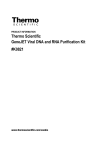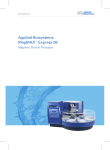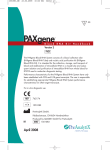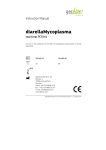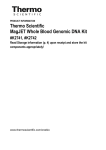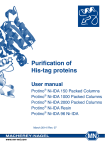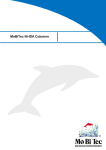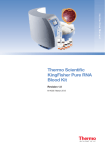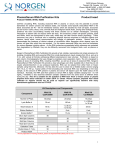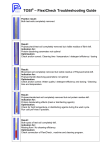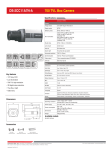Download Viral DNA/RNA Purification Kit
Transcript
CONTENTS Viral DNA/RNA Purification Kit 50 REF DK0011 For isolation and purification of viral nucleic acids from human plasma or serum samples for in vitro diagnostic purposes For in vitro diagnostic use page Components of the kit .............................................................................................................3 Symbols...................................................................................................................................3 Storage and stability ................................................................................................................4 Quality control .........................................................................................................................4 Intended use ............................................................................................................................4 Product use limitation ...............................................................................................................4 Description ..............................................................................................................................5 Principle...................................................................................................................................5 Important notes .......................................................................................................................6 Sample handling......................................................................................................................6 Preparing reagents and buffers ...............................................................................................7 Carrier RNA .............................................................................................................................7 Preparation of carrier RNA ......................................................................................................7 Calculating the required quantity of carrier RNA .....................................................................8 Internal control.........................................................................................................................8 Additional materials and equipment required ..........................................................................8 Protocol overview ....................................................................................................................9 Viral DNA/RNA isolation and purification protocol ............................................................... 10 Safety information ................................................................................................................ 13 References ........................................................................................................................... 14 Fermentas UAB, A wholly owned subsidiary of Thermo Fisher Scientific, Inc. V.A. Graičiūno 8 LT-02241 Vilnius, Lithuania +370 700 55131 ID PA-DK001_EN Rev.05/01.2013 2 STORAGE AND STABILITY COMPONENTS OF THE KIT REF DK0011 Viral DNA/RNA Purification Kit CPL LS WB1 WB2 EL PK CR LT WT ET Column Preparation Liquid (red cap) Lysis Solution* Wash Buffer 1 (concentrated)* Wash Buffer 2 (concentrated) Eluent (white cap) Proteinase K (green cap) Carrier RNA (blue cap) Lysis Tubes (1.5 mL) Spin Columns preassembled with Wash Tubes Wash Tubes (2 mL) Elution Tubes (1.5 mL) HB Handbook SC 50 When the kit is delivered, remove the Carrier RNA (CR) from the package and store in the original aluminum bag at −20°C. Other components of the kit should be stored at room temperature (15-25°C). All components are stable until the listed expiration date. Wash Buffer 1 (WB1) and Wash Buffer 2 (WB2) are stable until the listed expiration date after addition of ethanol. LYS│TUBE 2 x 1.4 mL 12 mL 25 mL 11 mL 3 x 1.25 mL 2 x 1.3 mL 1 vial 50 COL 50 INTENDED USE WASH│TUBE 4 x 50 50 The Viral DNA/RNA Purification Kit is a general-purpose device intended for isolation and purification of viral nucleic acids from human plasma or serum samples for in vitro diagnostic purposes. 1 Any diagnostic results generated using the sample preparation procedure in conjunction with any downstream diagnostic nucleic acid technology (NAT) assay should be interpreted with regard to other clinical or laboratory findings. The product is intended for use by professionals such as technicians and physicians trained in in vitro molecular diagnostic techniques. COL │PREP│LIQ LYS │SOLN WASH│BUF│1│CONC WASH│BUF│2│CONC ELU PROTK CAR│RNA ELU│TUBE * contains guanidine hydrochloride (guanidinium chloride). SYMBOLS Attention - see instructions for use! ADD Add indicated component Batch code COMP Components Use by CONT Contains In vitro diagnostic medical device EtOH Ethanol QUALITY CONTROL The Viral DNA/RNA Purification Kit meets the essential requirements as outlined on Directive 98/79/EC, Annex I, and is in compliance with the requirements of Directive 98/79/EC, Annex III. The quality of the product is controlled using validated procedures. In accordance with our Company Quality Management System, each lot of the Viral DNA/RNA Purification Kit is tested against predetermined specifications to ensure consistent product quality. A certificate of analysis of the product is available upon request. The Viral DNA/RNA Purification Kit is designed to be used with any downstream application employing enzymatic amplification or other enzymatic modification of DNA or RNA followed by signal detection. The isolated and purified viral nucleic acids can be used in qualitative (e.g., blood screening) as well as quantitative (e.g., viral load monitoring) diagnostic NAT assays. Manufacturer ID Material identification number To minimize irregularities in diagnostic results, the product must be used with an appropriate internal control as well as positive and negative controls throughout the process of sample preparation, amplification and detection. Consult instructions for use VOL Volume or quantity PRODUCT USE LIMITATION Catalogue number Leads to Temperature limitation After addition of ethanol mark the completed step Kit contains reagents 50 sufficient for 50 sample preparations Remove Carrier RNA immediately upon the arrival and store at −20°C 3 The Viral DNA/RNA Purification Kit is not for use with whole blood, tissue or cultured cells. The performance of the kit in isolating and purifying viral nucleic acids from other cellfree body fluids (such as urine and CSF) has not been evaluated. The yields of viral nucleic acids may depend on the type of virus. Plasma or serum samples from heparin treated blood are not suitable for use. The user is responsible for validating the performance characteristics necessary for downstream diagnostic applications. 4 DESCRIPTION IMPORTANT NOTES The Viral DNA/RNA Purification Kit utilizes a silica-based membrane technology in the form of a convenient spin column. Viral nucleic acids from lysed plasma or serum samples bind to the column membrane while impurities are effectively removed during subsequent washing and centrifugation steps. Finally, ready-to-use nucleic acids are eluted from the column. The purified viral nucleic acids are free of proteins, nucleases, and other contaminants or inhibitors of downstream applications. Isolated DNA/RNA can be directly used in PCR, qPCR or other nucleic acid based assays. Ensure the integrity of the kit components upon the delivery. Contact technical service or your local distributor in case of damage. Do not use damaged kit components. PRINCIPLE The Viral DNA/RNA Purification Kit uses a well-established nucleic acid isolation and purification technique comprised of following steps: 1 Sample lysis The sample is lysed by incubation with Lysis Solution (LS) and Proteinase K (PK) under denaturating conditions at elevated temperatures (56°C). The Lysis Solution and Proteinase K inactivate both RNases and DNases, ensuring protection of viral nucleic acids against degradation. 2 Binding viral nucleic acids to the spin column membrane The lysed sample is transferred to a spin column (SC) where released viral nucleic acids immediately bind to the silica-based filter in the presence of chaotropic salts. The remaining lysate is removed by centrifugation. 3 All sample material and waste should be regarded as potentially infectious. Wear the proper protection when handling samples and waste. Avoid any skin or eye contact! Work under laminar air flow conditions if possible until samples are lysed. Disinfect all work surfaces thoroughly after the procedure. Follow proper waste disposal guidelines as recommended by local authorities. The following steps should be taken in order to avoid cross-contamination: always change pipette tips between liquid transfers (aerosol-barrier pipette tips recommended); open only one tube at a time; use disposable gloves and discard if contaminated. Always use RNase-free equipment. Use only a freshly prepared mixture of Carrier RNA (CR) and Lysis Solution (LS) when beginning a new extraction procedure! Before beginning the procedure, a new Spin Column (SC) must be prepared by adding 50 µL of Column Preparation Liquid (CPL) into the center of the column membrane. Do not centrifuge the column after addition of CPL. The kit should be only used by professional personnel trained in IVD practices. Removing remaining contaminants The remaining contaminants are removed during three wash steps using Wash Buffer 1 (WB1) and Wash Buffer 2 (WB2), whereas pure nucleic acids remain bound to the membrane. 4 The Lysis Solution (LS) and Wash Buffer 1 (WB1) contain irritants. Always wear gloves and follow standard safety precautions when handling these reagents. For more information refer to SAFETY INFORMATION (page 13) and Material Safety Data Sheets (available by request). Elution of pure viral nucleic acids Pure viral nucleic acids are released from the spin column filter using Eluent (EL). The resulting purified nucleic acids are ready for subsequent use in downstream NAT applications. SAMPLE HANDLING After collection and centrifugation, plasma/serum samples can be stored at 2-8°C for up to 6 hours or frozen at −20°C or −70°C for long-term storage. Do not freeze/thaw samples more than once. Equilibrate samples to room temperature (20±5°C) before use. Remove precipitates, if any, by centrifugation for 5 min at 3000 x g. Use EDTA or citrate treated samples. Heparin treated samples are not suitable for use with the kit. 5 6 CALCULATING THE REQUIRED QUANTITY OF CARRIER RNA PREPARING REAGENTS AND BUFFERS Add the indicated volume of ethanol (96-100%) to the concentrated Wash Buffer 1 (WB1) and concentrated Wash Buffer 2 (WB2) prior to first use: REF DK0011 50 Wash Buffer 1 (WB1) Wash Buffer 2 (WB2) Concentrated wash buffer 25 mL 11 mL Ethanol (96-100%) 15 mL 44 mL Total volume 40 mL 55 mL Ensure all working solutions are prepared according to the recommendations in the protocol. After preparing each solution, mark the bottle to indicate that this step has been completed. Check all solutions in the kit for any salt precipitation before each use. Re-dissolve any precipitate by warming the solution to 37°C, and then equilibrate to room temperature (20±5°C). It is the user’s responsibility to use appropriate controls during the procedure. CARRIER RNA Usage of Carrier RNA (CR) is important for efficient recovery of viral nucleic acids for two reasons. First, CR facilitates binding of viral nucleic acids to the silica membrane, especially when there are only a small number of viral nucleic acid molecules in the sample. Additionally, in the rare event when there are a small number of active RNase molecules, large amounts of Carrier RNA reduce the probability of viral RNA being degraded under chaotropic conditions. If Carrier RNA is not added to the Lysis Solution (LS), reduced viral nucleic acid yields may result. PREPARATION OF CARRIER RNA Carrier RNA (CR) is provided in a dried state packed in a moisture-impermeable aluminum bag. Prior to the first use, reconstitute the dried Carrier RNA (CR) by adding 300 µL of Eluent (EL). Allow the freshly reconstituted Carrier RNA (CR) to incubate for 5 min at room temperature, then mix thoroughly and briefly centrifuge the vial. Use immediately or store at −20°C. Do not freeze-thaw the reconstituted Carrier RNA (CR) more than 10 times. If only few samples will be processed at a time, divide the Carrier RNA (CR) solution into 50 µL aliquots (using nuclease-free tubes) and store at −20°C. 7 When starting a new procedure, always use a freshly prepared mixture of Carrier RNA (CR) and Lysis Solution (LS). To calculate the correct quantity of Carrier RNA (CR) and Lysis Solution (LS) required to process multiple samples, use the following table. Supplement Lysis Solution with the required quantity of Carrier RNA (CR) and mix by pulse-vortexing or pipetting. No. samples Vol. Lysis Vol. Carrier Solution (LS), mL RNA (CR), µL No. samples Vol. Lysis Solution (LS), mL Vol. Carrier RNA (CR), µL 1 0.22 5.5 13 2.86 71.5 2 0.44 11.0 14 3.08 77.0 3 0.66 16.5 15 3.30 82.5 4 0.88 22.0 16 3.52 88.0 5 1.10 27.5 17 3.74 93.5 6 1.32 33.0 18 3.96 99.0 7 1.54 38.5 19 4.18 104.5 8 1.76 44.0 20 4.40 110.0 9 1.98 49.5 21 4.62 115.5 10 2.20 55.0 22 4.84 121.0 11 2.42 60.5 23 5.06 126.5 12 2.64 66.0 24 5.28 132.0 Note: Required volumes (µL) of Carrier RNA (CR) are calculated using following formula: N x 0.22 mL = Y mL Y mL x 25.0 µL/mL = Z µL Where: N – number of samples to be processed; Y – calculated volume (mL) of Lysis Solution (LS); Z – volume (µL) of Carrier RNA (CR) to add to Y mL of Lysis Solution (LS). INTERNAL CONTROL The presence of an internal control throughout the extraction and purification procedure is necessary when using the kit in combination with diagnostic amplification systems. Please refer to the user manual provided with the downstream diagnostic assay for further directions on how to use an internal control. ADDITIONAL MATERIALS AND EQUIPMENT REQUIRED Pipettes and sterile, nuclease-free pipette tips with aerosol barrier Vortex Ethanol (96-100%) Microcentrifuge Thermomixer Disposable gloves Measuring cylinder Nuclease-free microcentrifuge tubes of an appropriate size for preparing mixtures of Carrier RNA (CR) and Lysis Solution (LS) 8 VIRAL DNA/RNA ISOLATION AND PURIFICATION PROTOCOL PROTOCOL OVERVIEW Read the protocol (page 10) carefully before beginning! Ensure that you are familiar with the symbols and abbreviations of each component of the kit (page 3). Procedure timing for processing one sample ~30 min. Timing - Column preparation Add 50 µL CPL on to SC membrane Do not centrifuge Lyse Load 200 µL of a sample into LT Add 200 µL LS (supplemented with CR) Add 50 µL PK Mix Incubate 15 min at 56°C in a thermomixer Add 300 µL of ethanol (96-100%) Mix Incubate 3 min at room temperature 15 min Transfer sample into SC Centrifuge 1 min 6000 x g Discard wash tube Place SC into a new WT 1 min Adjust binding conditions Bind Wash (WB1) Wash (WB2) Wash (WB2) Spin dry Elute Store Add 700 µL WB1 into SC Centrifuge 1 min 6000 x g Discard wash tube Place SC into a new WT Add 500 µL WB2 into SC Centrifuge 1 min 6000 x g Discard WT Place SC into a new WT Add 500 µL WB2 into SC Centrifuge 1 min 6000 x g Discard WT Place SC into a new WT Centrifuge 3 min 16000 x g Discard WT Place the SC into ET Add 50 µL EL preheated to 56°C onto SC membrane Incubate 2 min at room temperature Centrifuge 1 min at 13000 x g Discard SC Keep ET containing pure viral nucleic acids Use the purified nucleic acids immediately or store at −20°C 9 3 min For isolation and purification of viral DNA/RNA from 200 µL of EDTA- or citrate- treated human plasma or serum. Do not use heparin-treated samples! The following procedure provides instruction for processing one sample. Before starting Read the user manual; make sure all the directions are followed as indicated. Make sure all working solutions and samples have been prepared according to recommendations (page 5-7). Ensure all necessary equipment and additional materials are available before beginning the procedure (page 7). Organize proper handling of potentially infectious waste before beginning the procedure. Follow recommended safety instructions, as you will be working with potentially infectious material. Attention and care must be taken during the entire process. All centrifugation steps must be performed at room temperature. Procedure 1) Spin Column preparation 1 min Before starting the procedure, each new Spin Column (SC) must be prepared by treating it with Column Preparation Liquid (CPL). Column treatment maximizes binding of the nucleic acids to the membrane, resulting in more consistent yields. 1 min a. Add 50 µL of Column Preparation Liquid (CPL) to the center of Spin Column (SC) membrane, so that the membrane is entirely moistened. 1 min 3 min 2+1 min CPL COL│PREP│ LIQ SC COL Do not centrifuge the prepared column. The prepared column should be stored at room temperature until it is used for sample processing. 2) Sample lysis Kit components used: Supplement Lysis Solution (LS) with Carrier RNA (CR) prior to use (page 8)! Use the appropriate internal control as required in a downstream assay user’s manual. Do not add the internal control directly to plasma samples. Do not add Proteinase K (PK) directly to Lysis Solution (LS). a. Load 200 µL of serum or plasma sample to an empty 1.5 mL Lysis Tube (LT). b. Add 200 µL of Lysis Solution (LS) (supplemented with Carrier RNA), and 50 µL of Proteinase K (PK), mix thoroughly by vortexing or pipetting. c. Incubate the sample for 15 min at 56°C in a thermomixer. Leave thermomixer turned on for Eluent (EL) preheating later during procedure. d. Centrifuge for 3-5 s at full speed to collect any sample solution from the inside of the lid. 10 Kit components used: CR CAR │RNA LS LYS │SOLN LT LYS │TUBE PK PROTK User supplied: Internal controls for a downstream application 3) Adjusting binding conditions 7) Repeated washing with Wash Buffer 2 (WB2) a. Add 300 µL of ethanol (96-100%) and mix by pipetting or vortexing. b. Incubate the sample at room temperature for 3 min. c. Centrifuge for 3-5 s at full speed to collect drops from the inside of the lid. User supplied: Ethanol (96-100%) a. Add 500 µL of Wash Buffer 2 (WB2) supplemented with ethanol to the Spin Column (SC). b. Centrifuge the column for 1 min at 6000 x g. c. Discard the Wash Tube containing flowthrough. d. Place the Spin Column (SC) into a new 2 mL Wash Tube (WT). 4) Binding nucleic acids to the spin column Ensure that a new Spin Column (SC) has been prepared as described in step 1! Kit components used: SC COL a. Centrifuge the column for 3 min at 16000 x g. b. Discard the Wash Tube (WT) containing remaining flow-through. 9) Elution of pure nucleic acids a. Place the Spin Column (SC) into a new 1.5 mL Elution Tube (ET). b. Add 50 µL of Eluent (EL) preheated to 56°C to the center of Spin Column (SC) membrane. c. Incubate for 2 min at room temperature. d. Centrifuge the column for 1 min at 13000 x g. e. Discard the Spin Column (SC). 5) Washing with Wash Buffer 1 (WB1) Supplement concentrated Wash Buffer 1 (WB1) with ethanol prior to the first use (Page 7)! Kit components used: WB1 WASH│BUFF|1|CONC WT WASH│TUBE a. Add 700 µL of Wash Buffer 1 (WB1) supplemented with ethanol to the Spin Column (SC). b. Centrifuge the column for 1 min at 6000 x g. c. Discard the Wash Tube containing flowthrough. d. Place the Spin Column (SC) into a new 2 mL Wash Tube (WT). Storage and use in downstream applications a. Keep the Elution Tube (ET) containing pure viral nucleic acids. b. Use the purified nucleic acids immediately or store at −20°C. 6) Washing with Wash Buffer 2 (WB2) Supplement concentrated Wash Buffer 2 (WB2) with ethanol prior to the first use (Page 7)! Kit components used: WB2 WASH│BUFF|2|CONC For further use in downstream qPCR applications, use 10 µL of viral DNA per 25 µL reaction volume. For reverse transcription (RT), use up to 10 µL of viral RNA per 20 µL cDNA synthesis reaction volume. WT WASH│TUBE a. Add 500 µL of Wash Buffer 2 (WB2) supplemented with ethanol to the Spin Column (SC). b. Centrifuge the column for 1 min at 6000 x g. c. Discard the Wash Tube containing flowthrough. d. Place the Spin Column (SC) into a new 2 mL Wash Tube (WT). 11 WT WASH│TUBE 8) Spin dry WT WASH│TUBE a. Transfer the lysate to the prepared Spin Column (SC) preassembled within the wash tube. b. Centrifuge the column for 1 min at 6000 x g. c. Discard the Wash Tube containing flowthrough. d. Place the Spin Column (SC) into a new 2 mL Wash Tube (WT). Kit components used: WB2 WASH│BUFF|2|CONC 12 Kit components used: ET ELU│TUBE EL ELU SAFETY INFORMATION Proteinase K (PK) Xn Harmful Lysis Solution (LS) Xn Harmful Hazard-determining component of labeling: Guanidinium chloride Risk phrases R22 Harmful if swallowed. R38 Irritating to skin. R41 Risk of serious damage to eyes. R52/53 Harmful to aquatic organisms may cause long-term adverse effects in the aquatic environment. Safety phrases S23 Do not breathe gas/fumes/vapour/spray. S26 In case of contact with eyes, rinse immediately with plenty of water and seek medical advice. S36/37/39 Wear suitable protective clothing, gloves and eye/face protection. S60 This material and its container must be disposed of as hazardous waste. S61 Avoid release to the environment. Refer to special instructions/safety data sheets. Hazard-determining component of labeling: Proteinase, Tritirachium album serine Risk phrases R42 May cause sensitization by inhalation. Safety phrases S23 Do not breathe gas/fumes/vapor/spray. S36 Wear suitable protective clothing. S45 In case of accident or if you feel unwell, seek medical advice immediately (show the label where possible). S60 This material and its container must be disposed of as hazardous waste. Material Safety Data Sheet of the product is available upon the request. Field Safety Notice: Fax.: +370 5 2602142 Email: [email protected] Wash Buffer 1 (WB1) Xn Harmful Hazard-determining component of labeling: Guanidinium chloride Risk phrases R22 Harmful if swallowed. R36/38 Irritating to eyes and skin. Safety phrases S23 Do not breathe gas/fumes/vapour/spray. S26 In case of contact with eyes, rinse immediately with plenty of water and seek medical advice. S36/37 Wear suitable protective clothing and gloves. S60 This material and its container must be disposed of as hazardous waste. 13 REFERENCES 1. Boom, R., C.J.A. Sol, M.M.M. Salimans, C.L. Jansen, P.M.E.W. Dillen, and J. van der Noordaa. 1990. Rapid and simple method for purification of nucleic acids. J. Clin. Microbiol. 28:495–503. 14







